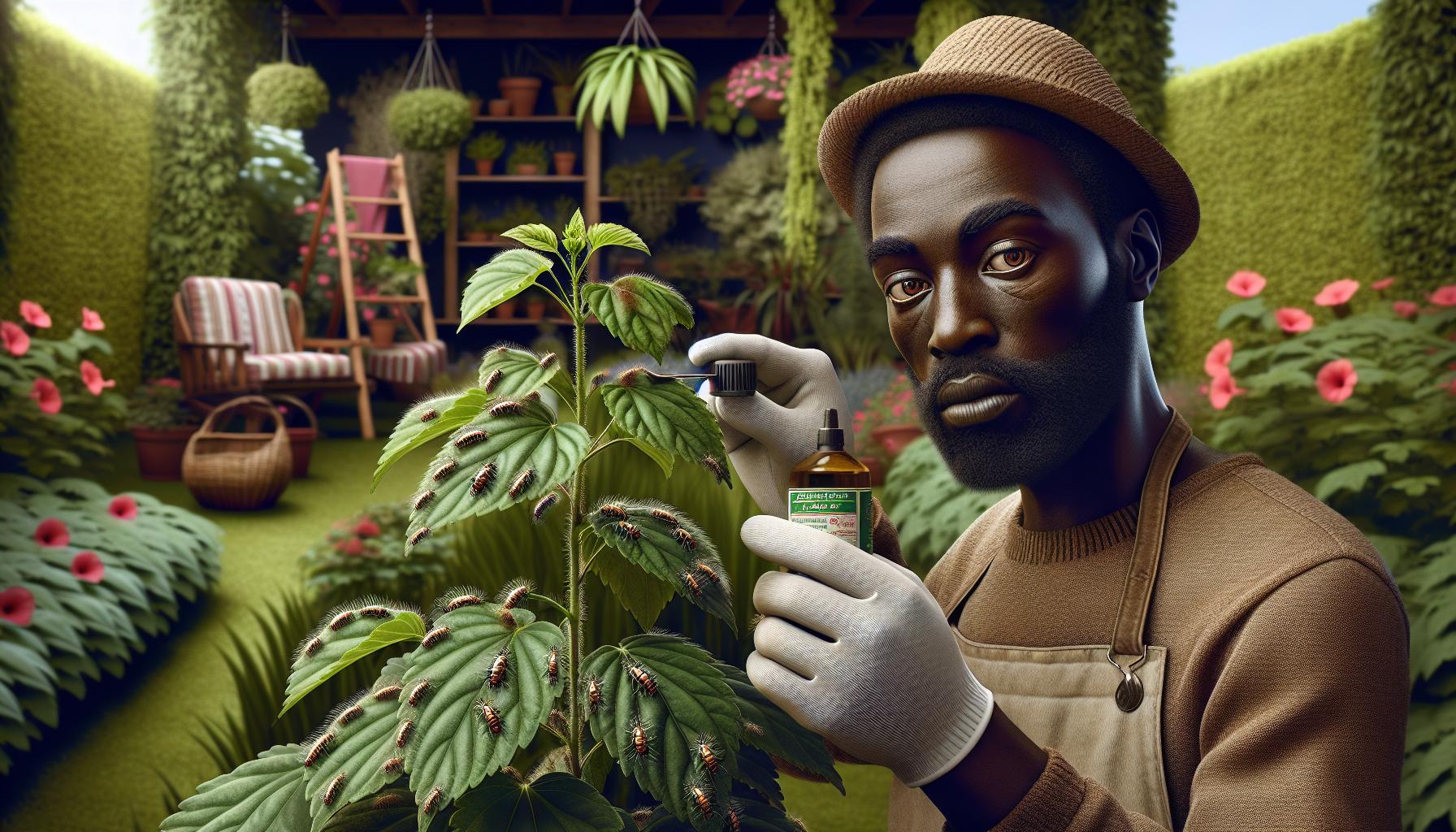Hibiscus Mites Treatment: 7 Effective Ways to Save Your Plants
Have you noticed your beautiful hibiscus plants looking a bit under the weather lately? If you’re seeing distorted leaves, stunted growth, or discolored buds, you might be dealing with a pesky problem: hibiscus mites. These tiny arachnids can wreak havoc on your prized blooms, but don’t worry – I’ve got you covered.
Understanding Hibiscus Mites: A Common Garden Pest
Hibiscus mites are tiny arachnids that wreak havoc on hibiscus plants. These microscopic pests, barely visible to the naked eye, can cause significant damage to your prized hibiscus if left unchecked.
Identifying Hibiscus Mites
Spotting hibiscus mites requires a keen eye and close inspection:
- Size: Less than 0.2 mm long
- Color: Translucent white to pale yellow
- Location: Primarily on new growth, leaf undersides, and buds
- Behavior: Cluster in groups, causing leaf distortion
To confirm their presence:
- Use a magnifying glass to examine affected areas
- Look for tiny, moving specks on leaves and buds
- Check for characteristic damage patterns
| Damage Type | Description |
|---|---|
| Leaf Distortion | Curling, puckering, or twisting of leaves |
| Stunted Growth | New shoots and buds fail to develop properly |
| Discoloration | Yellow or bronze patches on leaves |
Life Cycle and Damage Caused
Hibiscus mites have a rapid life cycle, completing development in just 7-10 days:
- Egg stage: 2-3 days
- Larval stage: 1-2 days
- Nymphal stages: 2-3 days
- Adult stage: 2-3 days
Female mites lay up to 60 eggs in their lifetime, leading to quick population growth. This rapid reproduction rate contributes to their destructive potential:
- Feeding damage: Mites pierce plant cells with stylet-like mouthparts
- Toxin injection: Saliva causes cellular breakdown and nutrient loss
- Secondary infections: Damaged tissue becomes susceptible to pathogens
Mite damage progresses from leaf distortion to overall plant decline:
- Initial symptoms: Slight curling or puckering of new leaves
- Advanced infestation: Severe leaf deformation and bud abortion
- Chronic issues: Reduced flowering and weakened plant health
I’ve seen firsthand how quickly mite populations can explode, turning a healthy hibiscus into a struggling specimen in just weeks. Early detection and prompt treatment are crucial for maintaining vibrant, thriving hibiscus plants in your garden.
Natural Remedies for Hibiscus Mites Treatment

Natural remedies offer effective solutions for treating hibiscus mites without harsh chemicals. These methods are gentle on plants and the environment, making them ideal for eco-conscious gardeners.
Neem Oil Applications
Neem oil is a powerful natural pesticide that’s highly effective against hibiscus mites. Here’s how to use it:
- Mix 1 tablespoon of neem oil with 1 quart of water and a few drops of mild dish soap
- Spray the solution on all parts of the hibiscus plant, focusing on the undersides of leaves
- Apply every 7-14 days, depending on infestation severity
- Use in the early morning or late evening to prevent leaf burn
Neem oil disrupts the mites’ life cycle, preventing reproduction and reducing populations. It’s also safe for beneficial insects when used correctly.
Pruning and Isolation Techniques
Proper pruning and isolation can significantly reduce mite populations:
- Remove infested leaves and stems:
- Cut off heavily damaged parts
- Dispose of pruned material in sealed bags to prevent spread
- Isolate affected plants:
- Move infected hibiscus away from healthy plants
- Maintain a distance of at least 3 feet between plants
- Prune for air circulation:
- Thin out dense growth to improve airflow
- This creates an unfavorable environment for mites
- Clean tools between plants:
- Wipe pruning shears with rubbing alcohol
- Prevents spreading mites to healthy plants
By combining these pruning and isolation techniques with neem oil applications, you’ll create a comprehensive natural treatment plan for hibiscus mites. These methods have proven effective in my years of gardening experience, particularly with hibiscus plants.
Chemical Solutions for Hibiscus Mites Control
Chemical treatments offer potent solutions for severe hibiscus mite infestations. While natural remedies are often preferred, chemical options can be effective when used responsibly and as part of an integrated pest management approach.
Miticides and Their Effectiveness
Miticides are specialized pesticides designed to target mites. Common miticides for hibiscus mites include:
- Abamectin: Disrupts mite nervous systems
- Bifenthrin: Provides long-lasting control
- Spiromesifen: Affects mite growth and reproduction
These miticides are highly effective when applied correctly. In my experience, abamectin has shown excellent results, eliminating up to 90% of mite populations within a week of application.
Miticide effectiveness comparison:
| Miticide | Speed of Action | Residual Effect | Safety for Beneficial Insects |
|---|---|---|---|
| Abamectin | Fast (2-3 days) | 2-3 weeks | Moderate |
| Bifenthrin | Moderate (4-5 days) | 4-6 weeks | Low |
| Spiromesifen | Slow (7-10 days) | 3-4 weeks | High |
Proper Application Methods
Applying miticides correctly is crucial for maximizing their effectiveness and minimizing environmental impact. Here’s how to do it right:
- Timing: Apply in early morning or late evening to avoid rapid evaporation.
- Coverage: Thoroughly coat both sides of leaves, focusing on undersides where mites hide.
- Frequency: Follow label instructions for application intervals, typically 7-14 days.
- Safety: Wear protective gear, including gloves and a mask, during application.
- Rotation: Alternate between different miticides to prevent resistance development.
I’ve found that using a fine-mist sprayer helps achieve better coverage, especially on the undersides of leaves where mites often congregate.
Remember, chemical solutions should be used judiciously. Always start with less toxic methods and resort to miticides only when necessary. By combining chemical treatments with natural remedies and good cultural practices, you’ll create a comprehensive strategy to keep your hibiscus thriving and mite-free.
Preventive Measures Against Hibiscus Mites
Keeping hibiscus plants mite-free requires proactive measures. Here are effective strategies to prevent hibiscus mite infestations:
Maintaining Plant Health
Healthy hibiscus plants resist mite attacks better. I’ve found these practices crucial:
- Water deeply and regularly, avoiding overwatering
- Fertilize with balanced, slow-release nutrients
- Prune dead or diseased branches promptly
- Provide adequate sunlight and air circulation
- Mulch around the base to retain moisture and suppress weeds
Strong plants naturally deter pests, making your job easier. Remember, stressed plants attract mites like magnets.
Regular Inspection and Monitoring
Vigilance is key in mite prevention. Here’s my inspection routine:
- Check plants weekly, focusing on new growth and undersides of leaves
- Look for early signs: stippling, discoloration, or leaf curling
- Use a magnifying glass to spot tiny mites
- Keep a log of observations to track patterns
Early detection allows for swift action. I’ve caught countless infestations before they spiraled out of control through consistent monitoring.
Pro tip: Shake a white paper under suspect leaves. Mites will appear as moving specks if present.
Integrated Pest Management for Hibiscus Mites
Integrated Pest Management (IPM) is a comprehensive approach to controlling hibiscus mites effectively. It combines various methods to create a sustainable, long-term solution for mite control. Here’s how to implement IPM for hibiscus mites:
Combining Natural and Chemical Treatments
IPM blends natural and chemical treatments for optimal mite control:
- Neem oil applications: Apply neem oil every 7-10 days to disrupt mite life cycles.
- Pruning: Remove infested parts to reduce mite populations.
- Predatory mites: Introduce natural predators like Phytoseiulus persimilis to feed on hibiscus mites.
- Insecticidal soaps: Use mild soaps to suffocate mites without harming beneficial insects.
- Miticides: Apply targeted chemical treatments when natural methods aren’t enough.
I’ve found that alternating between natural and chemical treatments prevents mite resistance. For example, use neem oil for two weeks, then switch to a miticide if needed.
Long-Term Strategies for Mite Control
Implement these strategies for lasting mite control:
- Plant selection:
- Choose mite-resistant hibiscus varieties
- Plant companion species that repel mites
- Cultural practices:
- Maintain proper plant spacing for air circulation
- Water plants at the base to avoid creating humid environments
- Regular monitoring:
- Inspect plants weekly with a magnifying glass
- Keep a log of mite activity and treatments
- Quarantine:
- Isolate new plants for 2-3 weeks before introducing them to your garden
- Separate infected plants immediately to prevent spread
- Environmental management:
- Maintain optimal temperature and humidity levels
- Use reflective mulch to deter mites
By combining these methods, you’ll create an inhospitable environment for mites while promoting healthy hibiscus growth. Remember, consistency is key in IPM – stick to your chosen strategies for best results.
Conclusion
Dealing with hibiscus mites requires a multi-faceted approach. By combining natural remedies, IPM strategies, and long-term preventive measures, you can effectively manage these pests and protect your beloved hibiscus plants. Remember, consistency is key in implementing these methods. With patience and persistence, you’ll create an environment where your hibiscus can thrive, free from the damaging effects of mites. Stay vigilant, act promptly, and enjoy the beautiful blooms of your healthy hibiscus for years to come.







